Ireland's Dolphins |
Dolphins are probably the last things that come to mind when thinking of Ireland. It might come as a surprise, though, that Irish coastal waters are home, both temporarily and permanently, to many species of cetaceans.
Common dolphin, bottlenose dolphin and harbour porpoise are among the residents. Killer whales, humpback whales and minke whales are among the regular visitors who come close to shore especially in the late summer and autumn months.
The most famous of Ireland's cetaceans are, however, the Shannon dolphins. The Shannon is Ireland's longest river and opens into a wide estuary between the counties Kerry and Clare. At the end of the estuary where the river mingles with the Atlantic Ocean live a group of bottlenose dolphins, locally known as the Shannon dolphins. The mouth of the Shannon, with its rapid tidal flows, provides excellent feeding grounds for these animals and it is thought that around 100 animals are permanent residents in the estuary and are joined by traveling dolphins during the salmon season in late summer.
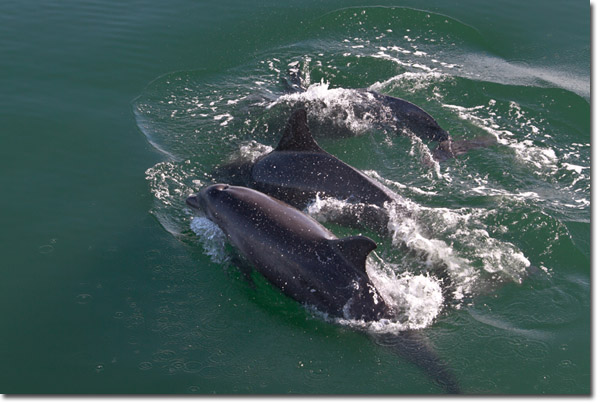
Dolphin watching has become an important part of local tourism and currently there are tours available from Kilrush and Carrigaholt during spring, summer and autumn. Seeing dolphins on these tours is almost guaranteed. I have been on countless trips over the years and only once the dolphins chose not to appear.
Photographing the animals is a different story. The majority of dolphin images consist of a disappearing grey fin in equally grey water. It is Ireland after all. What everybody wants however is a portrait shot or even the infamous leaping dolphin.
The first step to a successful dolphin shot is the equipment. I have tried many combinations over the years and recently settled with a fast 70-200mm lens combined with a 1.4x extender. The animals come very close to the boat so there is really no need for monster lenses. Regarding the camera, the faster the better. Dolphins are speedy animals and a fast and reliable AF and a high frame rate is definitely helpful. Having said that, I have to admit that I successfully work with "only" 3.9 fps and 9 AF points. I usually select one AF point and try to match this one as close to the dolphin's eye as possible. Letting the camera select the AF point results in perfectly in focus waves and a blurred dolphin for most of times.
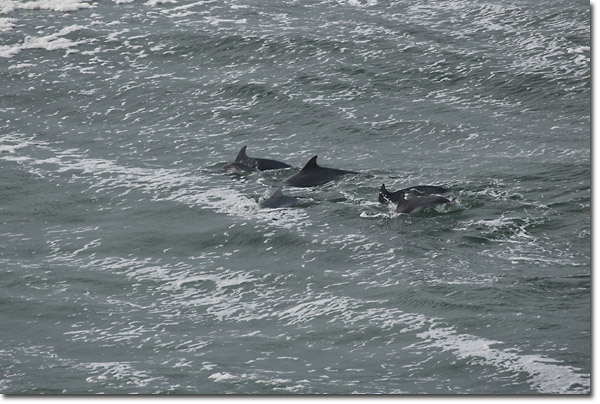
As so often in wildlife photography, the key to a sharp exposure (apart from the reliability of the AF) is a fast exposure time, 1/500 and faster is my rule of thumb. To achieve that I have several tools at my disposal: ISO, f-stop and exposure compensation. Depending on the weather conditions, I rarely go beyond ISO 400, my f-stop of choice is f8, and a slight to daring under exposure (-1/3 to –1) usually does the trick of getting a sharp and correctly exposed frame.
Speaking of weather, the best conditions to photograph dolphins at the Shannon Estuary are calm (or even calmer), a little sunlight, and a weak tidal flow. The first obviously influences the water surface and movements of the boat, the latter the visibility under water. If you have a calm surface, some direct light and only a small amount of dust particles in the water it is possible to track the movements of the dolphins under water and anticipate when they will break the surface (and that's the moment when you press the shutter, but I am sure you have figured that out yourself). Direct sunlight is a mixed blessing. It gives texture and depth to the images but unfortunately can also create unwanted reflection on both the water surface and the animals and can also result in blown highlights.
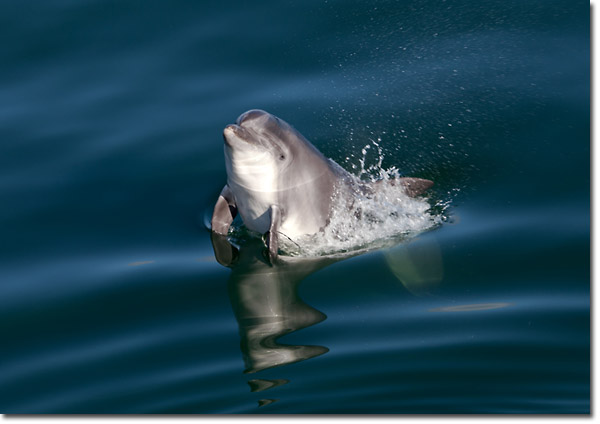
Under less favorable weather conditions, which unfortunately are more common in Ireland, it is a guessing game to where and when the animals will surface.
The dolphin watch boats stay with the animals for around 20 minutes (a longer stay could affect the dolphin's general behavior in the long term and should be avoided). Dolphins are curious and playful but also lose interest after a while. Therefore the first 10 minutes are usually the best and most productive for the photographer. The dolphins stay very close to the boat and tend to show off – bow riding, frequent surfacing, leaping or fish tossing provide excellent photo opportunities. After the first 10 minutes or so the animals usually make more scattered appearances.
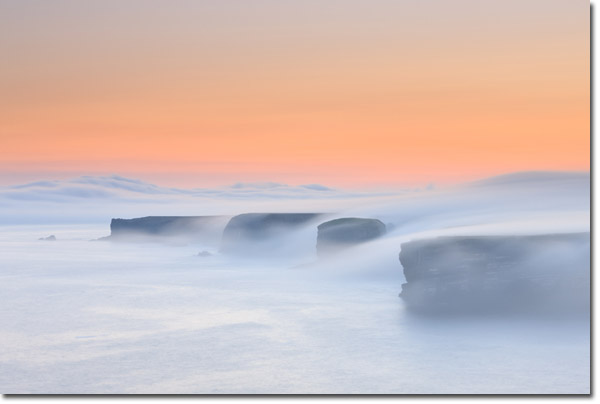
Finally a word on safety: Photographing from a bopping boat is difficult and taking unnecessary risks doesn't help getting good images. Don't lean over the rail, always keep both feet on deck and wearing a life jacket isn't a bad idea either. Securing the camera to your body in some way is also recommended. I have been using a wristband ever since I lost a camera in the depths of the Shannon Estuary.
And of course there are not only the bottlenose dolphins. The Shannon Estuary is also blessed with a rich bird life, seals, feral goats, and a stunning scenery.
Comments on NPN landscape photography articles? Send them to the editor. NPN members may also log in and leave their comments below.
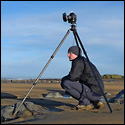 Carsten Krieger is a professional landscape and nature photographer based in the West of Ireland. His unique images are highly acclaimed and over the past decade he has become one of Ireland's leading photographers.
Carsten Krieger is a professional landscape and nature photographer based in the West of Ireland. His unique images are highly acclaimed and over the past decade he has become one of Ireland's leading photographers.
Conservation naturally plays an important role in his work. He has been working as staff photographer for the IPPC (Irish Peatland Conservation Council), was the picture editor & photographer for the environmental magazine Rocky Road and is currently representing Ireland at the international Meet Your Neighbours project.
Carsten has to date published four books, including the best selling The West of Ireland and The Wildflowers of Ireland and is currently working on several new projects. More info on Carsten and current projects can be found on his website, www.carstenkrieger.co.uk or his Facebook page.